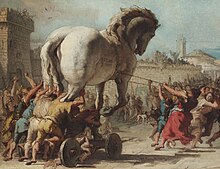Today I am Honored to post a wriiting from a very good friend who wishes to remain nameless, his nom de guer is El Graecae.
He brings to us on of those many afternoon recollections when you are working on something and a burst of literary thoughts, captures your innermost emotions and a great reflection is written.
And it deal with GEOpolitics, as this blopg was set up for, to express dialog, to focus in at the big picture, the concerns we should all care for in our countries, our neighbors and elsewhere .
The situtation in Venezuela, Bolivia, Chile. Ecuador, Nicaragua, Cuba and Mexico have all been recipients of this Trojan Horse. Places we thought would never falter like Chile and Colombia are now on the Scopes and yes there is a massive plan, orchestrated, don't be fooled.
Abroad you can see the issues in Iraq, Lebannon, and even Iran. the tranformation of Europe. which will be even more challenging in the next two decades.
Trojan horses are stil in use, in software, malware. even in the Cyberspace. But this philosophical beast disguised as compassion, equality, better future and peace is all too well know and still our youth, and fellow citizens fall for with free medical care, free college and many other big government pledges that eventually bring all to a common misery level except those who end up in charge.
Read and enjoy el Greco's weekend inspiration, and call to all who still believe in the beauty of a grandiose Trojan horse without ever knowing what is to come.
El Coronel
https://images.app.goo.gl/M8pbA5UzuKrVHQQP8

The Trojan Horse of the 21st Century
" Anan's
Páris éklepse tin 'eni apó to philoxene paláti tou Meneláou, ali i Elás
anataraxike....."
"When Paris robs Helena of the hospitable Palace of
Menelaus, all of Greece was shaken....."
Thus begins the Trojan War, described by Homer in the 8th
century BC, in the context of Greek mythology, which chronicles a military
conflict between the Greeks and a coalition of armies "ajeos" (Greek: syllade): against the city of Troy and
its allies. According to Homer,
it would be a war response by the ajeos to rescue Helen from Sparta, who was
originally abducted by Prince Paris of Troy.
Only as a
historical and mythological preamble, this war was about ten long years long,
and the Greeks with their mighty army failed to cross the walls of the city of
Troy. In addition, the most famous Greek warrior, "Achilles",
tragically falls dead in combat, with which Athena, (Greek: ) Goddess of Wisdom, but also
paradoxically Jerarch of War and Civilization, conceives a plan to build a
"horse" and hide inside the best warriors of the camp
"Ajeo".
Athena, instruct
"Epeo", the best carpenter in the Greek army, the construction of
said horse, to honor the gods and be given to the Trojans as a war
trophy. The horse was engraved with the following sentence: "The
Greeks dedicate this offering to Athena, grateful for a safe return to their
homes after a long absence of ten years."
The Trojans,
great believers in the gods, did not suspect the Greeks' plan and fell
into deception by accepting that the horse was the sign of the surrender of the
Greeks and an offering for the goddess Athena.
In addition, the
Trojans naively decided to introduce it to the city and pass through with it
the walls that the Greeks in ten years of combat never managed to overcome.
The Trojans
celebrated their victory over the Greeks in a big way, while the latter waited
patiently inside the horse until the end of the party, then stormed the city
from within. The Greeks opened the city gates so that they could spend the
rest of the army "ajeo", and so began the beginning of the end, as
the Trojans could not defend themselves and the Greeks took for them the city
of Troy, but setting it on fire and finally destroying it. As a
result, the city of Troy and the Trojans simply remained for history....
The bad news is
that history stubbornly repeats itself. During the beginning of the 21st
century, noble Latin American people opened their doors to shelter hundreds of
thousands of citizens who simply walked their own fate, fleeing barbarism and
no matter how to die in the attempt. So did another noble island people,
where thousands risked their lives at sea, in order to bet on a better future. In
an interesting parallel with the history described by Homer some 29 centuries
before, hundreds of warriors hidden inside the horse, in this case hidden and
crouched under the mantle of humanitarian aid required by hundreds of
thousands, managed to pierce the walls of these noble peoples, only
waiting in silence to also storm, burn and destroy at the most opportune
moment.
Once again,
history is stubbornly and tragically repeated, and so these noble people fall
under the yoke of the irrational anarchy and barbarism of a few hundred
warriors, conceived only for the violence and destruction of Civilization.
History or
mythology always gives us excellent analogies from which to learn and thus
avoid the barbaric scenarios already described by Homer. Likewise, we can
learn from the "ajeos" or ancient Greeks, who under the same figure
of the goddess Athena, mixed wisdom, civilization and war, so that they could
survive to this day. There is little time left for the civilized world to
act in a timely manner, blending with wisdom, the difficult art of war and civilization, thus avoiding the destruction of the
"City of Troy", but this time in the 21st century.
Any resemblance
to Homer's "Troy City" of the 8th century BC and the Latin American
reality of the 21st century, unfortunately if it is a
coincidence. By not understanding it this way, we are destined to witness the
destruction of the Civilization of the 21st Century, which will remain equally
for history....
El Graecae
11/11/19
Hoy me siento honrado de publicar
una escritura de un muy buen amigo que desea permanecer sin nombre, su nom de
guer es El Graecae. Nos trae esos
muchos recuerdos de la tarde cuando estás trabajando en algo y un estallido de
pensamientos literarios, captura tus emociones más íntimas y se escribe una
gran reflexión.
Se trata de la
geopolítica, ya que este blog fue creado para expresar estos pensamientos incitar el dialogo, para
centrarnos en el panorama general, las preocupaciones que todos debemos cuidar
en nuestros países, nuestros vecinos y en otros lugares. La situación en en Venezuela, Bolivia, Chile. Ecuador,
Nicaragua, Cuba y México han sido receptores de este caballo de Troya. Lugares
que pensábamos que nunca flaquearían como Chile y Colombia están ahora en los alcances y sí hay un plan masivo, orquestado, no se deje engañar.
En el extranjero se pueden ver los problemas
en Irak, Líbano e incluso Irán. la transformación de Europa. que será aún más
difícil en las próximas dos décadas. Los
caballos de Troya todavía están en uso, en el software, el malware.
Los caballos de Troya están en uso,
en el software, el malware. incluso en el ciberespacio. Pero esta bestia
filosófica disfrazada de compasión, igualdad, mejor futuro y paz es demasiado
bien conocido y todavía nuestra juventud, y los conciudadanos caen con atención
médica gratuita, la universidad libre y muchas otras grandes promesas del
gobierno que finalmente traen todo a un nivel de miseria común, excepto
aquellos que terminan a cargo. Lee y
disfruta de la inspiración del fin de semana de El Greco, y llama a todos los
que todavía creen en la belleza de un grandioso caballo de Troya sin saber
nunca lo que está por venir.
El Coronel
El Caballo de Troya del Siglo XXI
“ Όταν Ό Παρις έκλεψε την Έλενη από το φιλόξενο παλάτι του Μενελάου, όλη η Ελλάς αναταραξικε..... ”
“ Ótan Ó Páris éklepse tin Éleni apó to filóxeno paláti
tou Meneláou, óli i Elás anataraxike.....”
“Cuando París roba a Helena del
hospitalario Palacio de Menelao, toda Grecia quedó sacudida .....”
Así comienza la guerra de
Troya, descrita por Homero en el Siglo VIII a.C., en el contexto de la mitología griega, la cual narra un conflicto militar
entre los Griegos y una coalición de ejércitos “ajeos”
(del griego:
Ἀχαιοί), contra la ciudad de Troya y sus aliados.
Según Homero, se trataría de una respuesta bélica por parte
de los ajeos para rescatar a Helena de Esparta, quien en principio, fue raptada
por el príncipe Paris
de Troya.
Solo como preámbulo
histórico y mitológico, dicha guerra llevaba unos diez largos años de duración,
y los griegos con su poderoso ejército no conseguían atravesar los muros de la
ciudad de Troya. Además, el más famoso
guerrero griego, “Aquiles”, cae trágicamente muerto en combate, con lo cual
Atenea, (del griego Ἀθήνα) Diosa de la Sabiduría, pero además
paradójicamente Jerarca de la Guerra y de la Civilización, concibe un plan para
construir un “caballo” y ocultar en su interior a los mejores guerreros del
campamento “Ajeo”.
Atenea, instruye a “Epeo”,
el mejor carpintero del ejercito griego, la construcción de dicho caballo, para honrar a los Dioses y
ser entregado a los Troyanos como trofeo de guerra. El caballo llevaba grabada
la siguiente frase: “Los griegos dedican esta ofrenda a Atenea, con agradecimiento
por un retorno seguro a sus casas después de una larga ausencia de diez años”.
Los Troyanos, grandes
creyentes en los dioses,
no sospecharon del plan de los Griegos y cayeron en el engaño aceptando que el
caballo era la señal de la rendición de los griegos y una ofrenda para la diosa
Atenea.
Adicionalmente, los
Troyanos decidieron ingenuamente introducirlo en la ciudad y traspasar con él
las murallas que los griegos en diez años de combate nunca lograron vencer.
Los Troyanos celebraron a
lo grande su victoria sobre los Griegos, mientras estos esperaron pacientemente
dentro del caballo hasta el final de fiesta, para después asaltar la ciudad
desde adentro. Los Griegos abrieron las puertas de la ciudad para que pudiera
pasar el resto del ejército “ajeo”, y así comenzó el principio del fin, ya que los
Troyanos no pudieron defenderse y los Griegos tomaron para ellos la ciudad de
Troya, pero incendiándola y finalmente destruyéndola. Como consecuencia, la
ciudad de Troya y los Troyanos simplemente quedaron para la historia….
La mala noticia es que la
historia, tercamente se repite. Durante los comienzos del Siglo XXI, nobles
pueblos latinoamericanos, abrieron sus puertas para dar cobijo a centenares de
miles de ciudadanos que simplemente caminaban a su suerte, huyendo de la
barbarie y sin importar morir en el intento. Igual ocurrió con otro noble
pueblo insular, donde miles arriesgaron sus vidas en el mar, con tal de apostar
por un mejor porvenir. En un interesante paralelismo con la historia descrita
por Homero unos 29 siglos antes, cientos de guerreros ocultos dentro del
caballo, en este caso escondidos y agazapados bajo el manto de la ayuda
humanitaria requerida por otros cientos de miles, lograron traspasar las
murallas de esos nobles pueblos, solo esperando en silencio para igualmente
asaltar, incendiar y destruir en el momento más oportuno.
Una vez más, la historia
terca y trágicamente se repite y, es así, como estos nobles pueblos caen bajo
el yugo de la anarquía y barbarie irracional de unos cientos de guerreros,
concebidos solo para la violencia y la destrucción de la Civilización.
La historia o la mitología
siempre nos brinda excelentes analogías de donde aprender y, evitar así, los
escenarios de barbarie ya descritos por Homero. Igualmente, podemos aprender de
los “ajeos” o antiguos griegos, quienes bajo la misma figura de la diosa
Atenea, mezclaron sabiduría, civilización y guerra, para poder así sobrevivir
hasta nuestros días. Queda poco tiempo para que el mundo civilizado pueda
actuar oportunamente, mezclando con sabiduría, el difícil arte de la Guerra y
de la Civilización, evitando
así la destrucción de la “Ciudad de Troya”, pero ésta vez en el Siglo XXI.
Cualquier parecido con la
“Ciudad de Troya” de Homero del Siglo VIII a.C. y la realidad Latinoamericana
del Siglo XXI, lamentablemente si es una coincidencia. Al no entenderlo
así, estamos destinados a presenciar la destrucción de la Civilización del
Siglo XXI, la cual quedará igualmente para la historia….
El
Graecae
11/11/19
La entrada del
caballo en Troya
Galería
Nacional de Londres.



















































